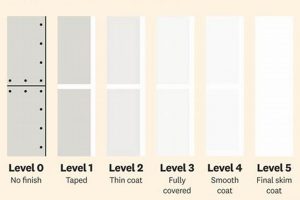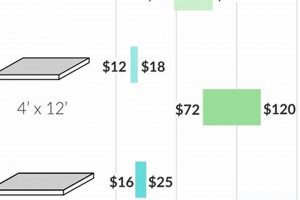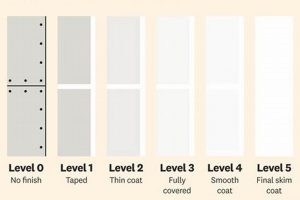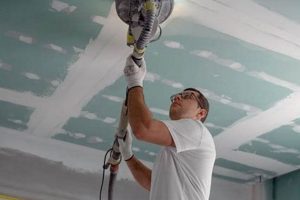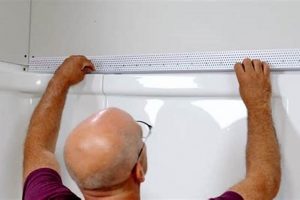The process of completing the intersection where two wall surfaces meet at an external angle requires specific techniques to ensure a durable and aesthetically pleasing result. This involves applying joint compound in multiple layers, embedding corner beads for reinforcement, and sanding to create a smooth, paintable surface. A properly executed edge protects the underlying drywall from impact and contributes significantly to the overall finished look of a room.
A well-executed corner provides structural integrity and prevents chipping or damage, thus extending the lifespan of the wall. Furthermore, sharp, clean lines enhance the visual appeal of the construction. Historically, various materials and methods have been used to achieve this, from simple wood trim to modern metal and composite corner beads, reflecting advancements in building materials and construction practices.
The following sections will detail the necessary tools, materials, and step-by-step instructions for achieving professional-quality edges, covering everything from corner bead installation to the final sanding and preparation for paint.
Tips for Optimal Edge Finishing
Achieving a professional-grade finish on external wall angles necessitates careful attention to detail. The following tips offer guidance for ensuring a durable and aesthetically pleasing outcome.
Tip 1: Select the Appropriate Corner Bead: Choose a corner bead material that suits the environmental conditions and anticipated level of impact. Metal beads offer superior protection in high-traffic areas, while paper-faced beads provide a smoother finish for painting.
Tip 2: Secure Corner Beads Properly: Ensure the corner bead is firmly attached to the drywall using nails, screws, or clinching tools. Inadequate attachment can lead to movement and cracking over time.
Tip 3: Apply Joint Compound in Thin Coats: Multiple thin coats of joint compound are preferable to a single thick coat. This minimizes the risk of shrinkage, cracking, and difficulty in sanding.
Tip 4: Allow Adequate Drying Time: Ensure each coat of joint compound is completely dry before applying the subsequent coat. Insufficient drying can result in adhesion problems and compromised structural integrity.
Tip 5: Sand Carefully and Evenly: Use a sanding sponge or block to avoid gouging the surrounding drywall. Employ progressively finer grits of sandpaper to achieve a smooth, seamless transition between the joint compound and the wall surface.
Tip 6: Feather the Edges of Joint Compound: Feathering the edges of each coat of joint compound minimizes the visibility of the repair and creates a more natural appearance.
Tip 7: Use a Primer Before Painting: Applying a primer before painting seals the joint compound and promotes better adhesion of the paint. This results in a more uniform and durable finish.
Adhering to these tips will contribute significantly to the quality and longevity of the finished product, resulting in a clean and professional look.
The subsequent sections will address common problems encountered during the finishing process and offer solutions for rectifying imperfections.
1. Corner bead selection
The selection of an appropriate corner bead is a foundational element influencing the successful execution of external angle finishing. The choice directly affects the durability, appearance, and ease of application of subsequent finishing materials. Improper selection can result in compromised structural integrity, increased susceptibility to damage, and aesthetic deficiencies. For example, utilizing a plastic bead in a high-traffic commercial environment is likely to lead to premature failure due to its lower impact resistance compared to metal alternatives. Conversely, employing a traditional metal bead where a softer, rounded edge is desired for aesthetic reasons might necessitate more extensive joint compound work to achieve the desired profile.
Further illustrating this connection, the environment and intended use of the finished corner dictate the optimal bead type. In moisture-prone areas, such as bathrooms, a vinyl bead might be preferable to a metal bead due to its resistance to corrosion. Paper-faced metal beads, while offering strong corner protection, are particularly suited for achieving a smoother finish because the paper surface readily accepts joint compound, facilitating seamless integration with the surrounding drywall. The precision in attachment is also influenced by bead selection; some designs allow for easier mechanical fastening, while others require specific adhesives or clinching tools. Therefore, understanding the distinct characteristics of each bead type is paramount for efficient and effective external wall corner finishing.
In summary, corner bead selection is not a superficial preliminary step but an integral decision affecting the overall quality and longevity of the finished edge. Failing to consider factors such as anticipated impact, moisture exposure, and desired aesthetic can lead to costly repairs and dissatisfaction. Selecting the correct corner bead provides a solid foundation for a durable and visually appealing external corner. The material choices of the bead also link to the overall structural system being constructed which is why corner bead selection is an important factor.
2. Proper bead attachment
The secure affixation of a corner bead to the drywall substrate forms the cornerstone of achieving a durable and aesthetically pleasing external angle. Inadequate attachment compromises the structural integrity of the finished corner and negatively impacts the ease and quality of subsequent finishing stages.
- Mechanical Fastening Integrity
The use of nails or screws, spaced appropriately along the length of the corner bead, ensures a robust physical bond to the drywall. Insufficient fastener density or improper fastener depth can result in bead movement, leading to cracks in the joint compound and potential detachment over time. The type of fastener should be carefully considered based on the substrate material; drywall screws are preferred over nails due to their superior holding power and reduced likelihood of popping out. A real-world example illustrates the consequence of inadequate fastening: a corner subjected to regular impact may exhibit hairline fractures along the bead edge due to the beads inability to uniformly distribute the force. These cracks compromise the corner’s resistance and appearance, necessitating repair.
- Adhesive Application Effectiveness
Construction-grade adhesives can supplement or, in some cases, replace mechanical fasteners. However, the effectiveness of adhesive bonding hinges on proper surface preparation, including ensuring the drywall surface is clean and free of dust or contaminants. The adhesive must be applied in a continuous, uniform bead along the entire length of the corner. Insufficient adhesive or gaps in the application will weaken the bond and create points of stress concentration. A failure scenario involves applying adhesive to a dusty drywall surface, leading to compromised adhesion and subsequent bead separation under normal stresses, such as temperature fluctuations or minor impacts. Proper adhesive technique results in a uniformly bonded bead, distributing stresses across the entire surface.
- Clinching Tool Precision
For certain metal corner bead designs, clinching tools provide an alternative method of attachment. These tools crimp the metal bead onto the drywall, creating a mechanical interlock. The success of this method depends on the correct tool settings and consistent application of pressure. Over-crimping can damage the drywall, while under-crimping will result in a loose and unstable bead. An example of improper clinching is a bead that exhibits uneven crimping along its length, leading to localized stress points and increased susceptibility to impact damage. Precise and consistent clinching ensures a secure and durable corner, minimizing the risk of future cracking or separation.
- Alignment and Straightness Maintenance
Regardless of the chosen attachment method, maintaining proper alignment and straightness of the corner bead is crucial for achieving a professional-looking finish. A misaligned or crooked bead will result in an uneven corner that is difficult to correct with joint compound alone. Temporary bracing or supports may be necessary to hold the bead in place while the adhesive cures or while mechanical fasteners are applied. A corner bead that is installed out of plumb will create a noticeable visual distortion in the finished wall, diminishing the overall aesthetic appeal of the space. Careful attention to alignment during the attachment process sets the stage for a smooth and visually appealing final result.
These facets of bead attachment underscore its significance in the broader process of how to finish drywall outside corners. The selected technique and the meticulousness of its implementation influence not only the corner’s structural resilience but also the ease with which subsequent finishing stages can be executed, impacting the final aesthetic outcome. A secure and properly aligned corner bead provides a solid foundation for durable and visually seamless external wall angles.
3. Joint Compound Application
The application of joint compound is a critical phase in achieving professionally finished external wall angles. This process not only conceals the corner bead but also creates a smooth, paintable surface that contributes to the overall durability and aesthetic appeal of the corner.
- Layer Thickness and Adhesion
The application of joint compound in thin, even layers is paramount. Thick applications are prone to shrinkage, cracking, and reduced adhesion. Proper adhesion to the corner bead and surrounding drywall is essential for long-term durability. For example, applying excessive joint compound in a single layer can result in stress fractures as the compound dries, compromising the structural integrity of the corner. A methodical approach, utilizing multiple thin coats, minimizes these risks and promotes a stronger, more resilient finish.
- Feathering Technique
Feathering refers to the gradual tapering of the joint compound edges to blend seamlessly with the adjacent drywall surface. This technique is crucial for minimizing the visibility of the repair and creating a smooth transition. Poor feathering results in noticeable ridges and imperfections that detract from the overall appearance. Skilled application involves progressively widening each coat of joint compound to achieve a nearly imperceptible transition, ensuring a professional-quality finish.
- Joint Compound Type and Compatibility
The selection of joint compound type is essential for compatibility with the corner bead material and intended use. All-purpose joint compound, lightweight joint compound, and setting-type compounds exhibit varying properties in terms of drying time, hardness, and shrinkage. For instance, using a setting-type compound for the initial coats can provide increased strength and durability, while a lightweight compound may be preferable for the final coats due to its ease of sanding. Mismatched compound types can lead to adhesion problems and compromised structural integrity.
- Sanding Preparation
The quality of the joint compound application directly impacts the ease and effectiveness of the subsequent sanding process. A smooth, even application minimizes the amount of sanding required, reducing the risk of damaging the surrounding drywall. Excessive ridges and imperfections necessitate aggressive sanding, potentially exposing the corner bead or creating an uneven surface. Careful application, focusing on even distribution and feathering, facilitates efficient sanding and contributes to a professional-grade finish.
These facets of joint compound application are intrinsically linked to the overall objective of achieving durable and aesthetically pleasing external wall angles. Each step, from layer thickness to compound selection, influences the corner’s structural integrity, visual appeal, and ease of maintenance. A thorough understanding of these principles is essential for anyone seeking to master the art of how to finish drywall outside corners. Improper joint compound application often leads to callbacks for repairs and is a tell tale sign of the quality of the work being performed.
4. Sanding for smoothness
The process of sanding for smoothness is an indispensable component in achieving a professional and visually appealing finish on external drywall angles. Its purpose extends beyond mere cosmetic improvement, impacting the durability and longevity of the finished corner. The execution of sanding directly influences the uniformity of the painted surface and the resistance of the corner to impact and wear.
- Grit Selection and Progression
The selection of appropriate sandpaper grits, and their progressive application, is critical for achieving a smooth, defect-free surface. Coarser grits are employed initially to remove significant imperfections and ridges left by the joint compound application. Progressing to finer grits gradually refines the surface, minimizing the risk of scratching or damaging the underlying drywall. For example, initiating the sanding process with an overly fine grit would prove ineffective in removing substantial imperfections, while using an excessively coarse grit can result in deep scratches that are difficult to rectify. The progressive use of grits ensures efficient material removal and a uniformly smooth substrate for painting.
- Technique and Pressure Control
Consistent technique and controlled pressure are essential to prevent uneven sanding and potential damage to the corner bead or drywall. Applying excessive pressure in localized areas can create depressions or expose the corner bead, requiring additional joint compound and sanding to correct. Maintaining a consistent, sweeping motion distributes the sanding effort evenly, preventing the formation of ridges or flat spots. An example of improper technique is concentrating sanding effort on a single area, resulting in an uneven surface that is readily apparent after painting. The goal is to achieve a uniform texture across the entire corner, ensuring a seamless transition to the adjacent wall surfaces.
- Dust Mitigation and Safety
Sanding drywall generates significant amounts of dust, which poses respiratory hazards and can impede the sanding process itself. Implementing effective dust mitigation strategies, such as using a sanding block with a dust collection system or wearing a respirator, is crucial for protecting the worker’s health and maintaining visibility. Dust accumulating on the surface being sanded can clog the sandpaper and obscure imperfections, hindering the ability to achieve a smooth finish. A clean work environment and proper safety precautions are essential for efficient and effective sanding.
- Inspection and Refinement
Regular inspection of the sanded surface is necessary to identify and address any remaining imperfections. Using a bright light source to cast shadows across the corner can reveal subtle ridges, bumps, or scratches that might otherwise go unnoticed. Addressing these imperfections with targeted sanding and additional joint compound, if necessary, ensures a flawless final result. Failing to inspect the sanded surface thoroughly can lead to visible defects in the painted finish, detracting from the overall quality of the work. A meticulous inspection process allows for proactive correction and ensures a smooth, uniform surface ready for painting.
These facets of sanding for smoothness are inextricably linked to the quality and longevity of finished external drywall angles. Proper grit selection, technique, dust control, and inspection contribute to a surface that is not only visually appealing but also resistant to damage and wear. Effective sanding minimizes the visibility of the corner bead and creates a seamless transition between the corner and the adjacent wall surfaces, enhancing the overall aesthetic appeal of the space.
5. Painting preparation
Painting preparation is an integral stage following the completion of external drywall angle finishing. Proper preparation ensures optimal adhesion of paint, uniform color distribution, and a durable, aesthetically pleasing final result. Deficiencies in preparation can lead to paint failures, uneven texture, and a compromised overall appearance, regardless of the skill applied during earlier finishing stages.
- Surface Cleaning and Priming
Thoroughly cleaning the finished corner to remove dust, debris, and any residual joint compound is paramount for optimal paint adhesion. Priming the surface seals the joint compound, provides a uniform base for the paint, and enhances its bonding capabilities. Neglecting to prime a porous joint compound surface can result in uneven paint absorption, requiring multiple coats to achieve uniform color and coverage. For instance, unprimed areas may exhibit a dull or faded appearance compared to primed sections, creating an inconsistent visual texture. Priming establishes a stable foundation for the paint, improving its longevity and aesthetic appeal.
- Assessing and Correcting Imperfections
Before painting, a meticulous inspection of the finished corner is necessary to identify and correct any remaining imperfections, such as scratches, ridges, or unevenness. Addressing these flaws prior to painting prevents them from being amplified by the paint’s finish. A high-gloss paint, for example, will accentuate even minor imperfections, rendering them more noticeable. Filling small imperfections with spackle or applying a thin coat of joint compound followed by sanding creates a smoother, more uniform surface, minimizing the visibility of flaws in the final painted product.
- Caulking Application (If Necessary)
In certain applications, such as where the corner meets trim or adjacent surfaces, applying a bead of paintable caulk can create a seamless transition and prevent moisture intrusion. The caulk fills any gaps or crevices, resulting in a clean, professional appearance. Improper caulk application, such as applying too much or too little, can detract from the overall aesthetic and create areas where paint may crack or peel. A smooth, even bead of caulk enhances the finished corner’s appearance and provides an additional layer of protection against environmental factors.
- Paint Selection and Application Techniques
Selecting a paint that is compatible with the surface and intended use is crucial. The type of paint, sheen level, and application technique all influence the final result. Using a low-quality paint or applying it improperly can lead to peeling, chipping, or uneven coverage. Applying multiple thin coats of paint, rather than a single thick coat, ensures uniform coverage and a durable finish. The selection of appropriate brushes, rollers, and spray equipment contributes to a smooth, professional application, enhancing the overall appearance and longevity of the painted corner.
These elements of painting preparation collectively contribute to the success of external drywall angle finishing. Each facet, from surface cleaning to paint selection, impacts the final appearance and durability of the corner. Thorough preparation minimizes the likelihood of paint failures and ensures a professional, long-lasting result, thereby showcasing the quality of the preceding finishing work.
Frequently Asked Questions
The following section addresses common inquiries regarding the finishing of external drywall angles, providing clarity on best practices and addressing potential challenges.
Question 1: What is the most common cause of cracking along external drywall angles?
The most prevalent cause of cracking is insufficient adhesion between the corner bead and the drywall substrate. This can stem from inadequate fastener spacing, improper adhesive application, or a failure to adequately clean the drywall surface prior to bead installation.
Question 2: Is it necessary to prime drywall corners before painting?
Priming is essential. It seals the porous joint compound, promoting uniform paint adhesion and preventing variations in color and sheen. Failure to prime can lead to an uneven finish and reduced paint durability.
Question 3: What type of corner bead is most suitable for high-traffic areas?
Metal corner beads are generally recommended for high-traffic areas due to their superior impact resistance. Plastic or paper-faced beads may be more susceptible to damage in environments where they are frequently exposed to physical contact.
Question 4: How can one minimize dust during the sanding process?
Dust generation can be minimized through the use of sanding sponges or blocks equipped with dust collection systems. Additionally, wearing a respirator and ensuring adequate ventilation in the work area are advisable.
Question 5: What is the ideal number of joint compound coats for finishing an external drywall angle?
Typically, two to three thin coats of joint compound are recommended. Multiple thin coats minimize the risk of shrinkage and cracking compared to a single thick coat.
Question 6: How can one ensure a perfectly straight external drywall angle?
Maintaining proper alignment during corner bead installation is critical. The use of a level and temporary bracing can aid in achieving a straight and plumb corner. Consistent monitoring throughout the attachment process is essential.
These answers provide a foundation for successful external drywall angle finishing. Adherence to these guidelines promotes durable, aesthetically pleasing results.
The subsequent section will delve into advanced techniques and troubleshooting tips for complex corner finishing scenarios.
Conclusion
The detailed examination of how to finish drywall outside corners reveals a process demanding precision and adherence to established techniques. From corner bead selection and secure attachment to meticulous joint compound application, sanding, and preparation for painting, each step contributes to the durability and aesthetic quality of the finished edge. The preceding discussion has emphasized the importance of selecting appropriate materials, employing proper techniques, and mitigating potential problems to achieve professional-grade results.
Mastering this skillset necessitates diligent practice and attention to detail. The information presented serves as a comprehensive guide for achieving lasting, visually appealing drywall edges. Continued refinement of these techniques will contribute to enhanced building construction and improved interior aesthetics.


